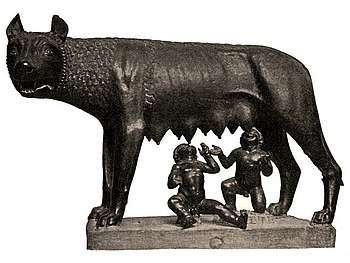Sacred grove
A sacred grove or sacred woods are any grove of trees that are of special religious importance to a particular culture. Sacred groves feature in various cultures throughout the world. They were important features of the mythological landscape and cult practice of Celtic, Baltic, Germanic, ancient Greek, Near Eastern, Roman, and Slavic polytheism, and continue to occur in locations such as India, Japan, and West Africa. Examples of sacred groves include the Greco-Roman temenos, various Germanic words for sacred groves, and the Celtic nemeton, which was largely but not exclusively associated with Druidic practice. During the Northern Crusades, there was a common practice of building churches on the sites of sacred groves. The Lakota and various other North American tribes consider particular forests or other natural landmarks to be sacred. Singular trees which a community deems to hold religious significance are known as sacred trees.
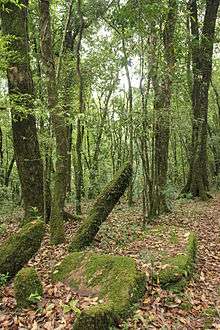
In history
Ancient Greece and Rome
The most famous sacred groves in mainland Greece was the oak grove at Dodona. Outside the walls of Athens, the site of the Platonic Academy was a sacred grove of olive trees, still recalled in the phrase "the groves of Academe".
In central Italy, the town of Nemi recalls the Latin nemus Aricinum, or "grove of Ariccia", a small town a quarter of the way around the lake. In Antiquity, the area had no town, but the grove was the site of one of the most famous of Roman cults and temples: that of Diana Nemorensis, a study of which served as the seed for Sir James Frazer's seminal work on the anthropology of religion, The Golden Bough.[1]
A sacred grove behind the House of the Vestal Virgins on the edge of the Roman Forum lingered until its last vestiges were burnt in the Great Fire of Rome in 64 CE.
In the town of Spoleto, Umbria, two stones from the late third century BCE, inscribed in archaic Latin, established punishments for the profanation of the woods dedicated to Jupiter (Lex Luci Spoletina) have survived; they are preserved in the National Archeological Museum of Spoleto.[2]
The Bosco Sacro (literally sacred grove) in the garden of Bomarzo, Italy, lends its associations to the uncanny atmosphere.
Lucus Pisaurensis,[3] the Sacred Grove of Pesaro, Italy was discovered by Patrician Annibale degli Abati Olivieri in 1737 on property he owned along the 'Forbidden Road' (Collina di Calibano),[3] just outside Pesaro. This Sacred Grove is the site of the Votive Stones of Pesaro and was dedicated to Salus, the ancient Roman demi-goddess of well-being.[4]
The city of Massilia, a Greek colony, had a sacred grove so close by it that Julius Caesar had it cut down to facilitate his siege.[5] In Pharsalia, the poet Lucan dramatized it as a place where sunlight could not reach through the branches, where no animal or bird lived, where the wind did not blow, but branches moved on their own, where human sacrifice was practiced, in a clear attempt to dramatize the situation and distract from the sacrilege entailed in its destruction.[6]
Ancient Near East
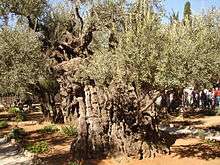
There are two mentions on this tradition in the Bible:
Abraham planted a grove in Beersheba, and called there the name of God.
- —Genesis 21:33
and
where the women wove hangings for the grove.
- —II Kings 23:7
Excavations at Labraunda have revealed a large shrine assumed to be that of Zeus Stratios mentioned by Herodotus[7] as a large sacred grove of plane trees sacred to Carians. In Syria, there was a grove sacred to Adonis at Afqa.
Baltic polytheism
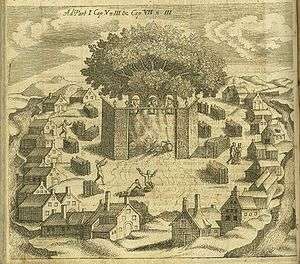
A sacred grove is known as alka(s) in Lithuanian and elks in Latvian, however, the terms are also sometimes used to refer to natural holy places in general.[8]
The first mention of Baltic sacred groves dates back to 1075 when Adam of Bremen noted Baltic Prussian sacred groves and springs whose sacredness was believed to be polluted by the entry of Christians (solus prohibetur accessus lucorum et fontium, quos autumant pollui christianorum accessu). A few sacred groves in Sambian Peninsula are mentioned in the 14th-century documents of the Teutonic Order (sacra sylva, que Scayte vulgariter nominatur..., silva, quae dicitur Heyligewalt...).[8] A religious centre of intertribal significance was Romuva (Romow) in Nadruvia, Prussia, as described by Peter of Dusburg in 1326.[9]
For Curonians sacred groves were closely associated with the cult of the dead. By the early 15th century, with the disappearance of cremation traditions among the Curonians the sacred groves of Courland had lost their crematory function but remained as an inviolable place reserved for the dead. The role of the sacred forests in the 16th-century traditions of Curonian Kings is described in a travel description by Königsberg apothecary Reinhold Lubenau[10]:
I first reached Mummel and then passed through Courland, reaching the Curonian king, where we had to watch his pagan superstitions. Since Christmas was approaching, they went hunting in their holy forest, where they do no hunting and do not cut a single rod throughout the rest of the year. All that they now hunted there: roe deer, red deer and hares, they skinned, cooked and placed on a long table. They fastened a large number of wax candles to the table, for the souls of their parents, children and relatives. After this, standing and walking to and fro, they ate and drank, and forced us to do likewise. Later, they brought an empty beer keg and beat on it with two sticks, and the men and women, as well as the children, danced around the table, something that continued for the whole night. When they went to bed one after another, they invited us to eat and take with us what we would, since they would not eat what was left over, but would give it to the dogs. Neither did they want to take any payment from us for what we had eaten.
— Reinhold Lubenau (20 December 1585)[10]
Celtic polytheism
The Celts used sacred groves, called nemeton in Gaulish, for performing rituals, based on Celtic mythology. The deity involved was usually Nemetona – a Celtic goddess. Druids oversaw such rituals. Existence of such groves have been found in Germany, Switzerland, Czech Republic and Hungary in Central Europe, in many sites of ancient Gaul in France, as well as England and Northern Ireland. Sacred groves had been plentiful up until the 1st century BC, when the Romans attacked and conquered Gaul. One of the best known nemeton sites is that in the Nevet forest near Locronan in Brittany, France. Gournay-sur-Aronde (Gournay-on-Aronde), a village in the Oise department of France, also houses the remains of a nemeton.[11][12]
Nemetons were often fenced off by enclosures, as indicated by the German term Viereckschanze – meaning a quadrangular space surrounded by a ditch enclosed by wooden palisades.
Many of these groves, like the sacred grove at Didyma, Turkey are thought to be nemetons, sacred groves protected by druids based on Celtic mythology. In fact, according to Strabo, the central shrine at Galatia was called Drunemeton.[13] Some of these were also sacred groves in Greek times (as in the case of Didyma), but were based on a different or slightly changed mythology.
Filipino animism
In the animistic native Filipino religions worshiping anito spirits, balete trees (Ficus spp.), also known as nonok or nunuk, were regarded as abodes of spirits or gateways to the spirit world. Cutting them down was taboo, a superstition that is still followed today. Outdoor shrines or altars known as dambana, latangan, and tambara among other names were often built near the trees during shaman rituals. Aside from individual trees, natural formations, bodies of water, rocks, groves, and even entire forests also commonly became sacred places to various communities.[14][15][16][17][18][19]
Germanic paganism
Trees hold a particular role in Germanic paganism and Germanic mythology, both as individuals (sacred trees) and in groups (sacred groves). The central role of trees in Germanic religion is noted in the earliest written reports about the Germanic peoples, with the Roman historian Tacitus stating that Germanic cult practices took place exclusively in groves rather than temples. Scholars consider that reverence for and rites performed at individual trees are derived from the mythological role of the world tree, Yggdrasil; onomastic and some historical evidence also connects individual deities to both groves and individual trees. After Christianization, trees continue to play a significant role in the folk beliefs of the Germanic peoples.
Today
Europe
Estonia
Based on historical data, it is estimated that there are around 2500 sacred natural sites in Estonia, the largest of them covering up to 100 hectares. Although rather exceptional among most of the technologically developed countries, in Estonia both the sacred natural sites and indigenous customs connected to them are still in use. Therefore, the heritage that is connected to sacred natural sites has great importance to the national identity and environment of Estonians.
In a collaboration between followers of Estonian native religion (Maausk) and governmental ministries, a national plan was prepared in 2008: "Sacred Natural Sites in Estonia: Study and Conservation 2008–2012" which includes about 550 sacred groves (Estonian: hiis). The National Plan on Sacred Natural Sites consists of a historical overview of sacred natural sites in Estonia, a current situation analysis, and several concrete conservation measures and instructions on how to apply them. The coordinating steering committee of the Conservation Plan consists of Environment, Agriculture, Internal Affairs and Education and Research ministries, National Heritage Board and MK. The University of Tartu is the implementing agency. Measures of the Conservation Plan are designed to handle natural sanctuaries and values connected to them in all aspects.
The Conservation Plan foresees creating a database which supports researching and managing natural sanctuaries. The database would consist of folkloric, archaeological, natural, historical and other data on sacred natural sites and provide information on the exact location, condition and form of ownership of each site.[20] In 2011 a scandal occurred when a company started clearcutting Rebala's sacred grove nearby Maardu manor due to a misunderstanding between the Environmental Board and the National Heritage Board.[21]
Latvia
There are three known sacred groves associated with the seven Curonian King villages in Turlava parish, Courland. The most famous one of them is the Ķoniņi Elka Grove (Ķoniņu Elka birzs) or simply Elka that today covers around one hectare of land and is protected as an archaeological monument of national importance. Folklore researcher Sandis Laime has suggested that the sacred grove might have been a religious centre and probably covered a more extensive area in the past. He points to the toponym Elka Meadow (Elku pļava) localized approximately 1.5 kilometres from the remaining grove and speculates that the meadow could have retained its original name even after the part of the sacred grove on it was cut down. Nowadays a strong oral tradition persists among the Turlava area residents regarding the prohibition of certain actions in the grove and the misfortune that may follow if the prohibitions are not abided.[10]
Lithuania
There are around 40 known sacred groves and forests in Lithuania. Lithuanian archaeologist Vykintas Vaitkevičius has grouped some of the sacred forests and groves according to the components šventas (13), alka (11) and gojus (more than 520) in their name.[9]
Africa
Ghana
Sacred groves are also present in Ghana. One of Ghana's most famous sacred groves – the Buoyem Sacred Grove – and numerous other sacred groves are present in the Techiman Municipal District and nearby districts of the Brong Ahafo Region. They provide a refuge for wildlife which has been exterminated in nearby areas, and one grove most notably houses 20,000 fruit bats in caves.[22] The capital of the historical Ghana Empire, contained a sacred grove called al-gâba (Ar. "the forest") for performing religious rites of the Soninke people. Other sacred groves in Ghana include sacred groves along the coastal savannahs of Ghana.[23] Many sacred groves in Ghana are now under federal protection – like the Anweam Sacred Grove in the Esukawkaw Forest Reserve[24] Other well-known sacred groves in present-day Ghana include the Malshegu Sacred Grove in Northern Ghana – one of the last remaining closed-canopy forests in the savannah regions,[25] and the Jachie sacred grove.
Nigeria
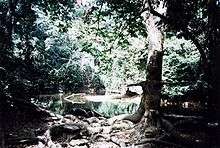
The concept of sacred groves is present in Nigerian mythology as well. The Osun-Osogbo Sacred Grove, containing dense forests, is located just outside the city of Osogbo, and is regarded as one of the last virgin high forests in Nigeria. It is dedicated to the fertility goddess in Yoruba mythology, and is dotted with shrines and sculptures. Oloye Susanne Wenger, an Austrian artist, helped revive the grove. The grove was declared a UNESCO World Heritage Site in 2005.[26]
Asia
India
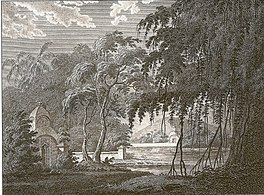
In India, sacred groves are scattered all over the country, and do enjoy protection. Prior to 2002, these forest regions were not recognized under any of the existing laws. But in 2002 an amendment was brought in Wildlife Protection Act, 1972 to include Sacred Groves under the act. Some NGOs work with local villagers to protect such groves. Each grove is associated with a presiding deity, and the groves are referred to by different names in different parts of India. They were maintained by local communities with hunting and logging strictly prohibited within these patches. While most of these sacred deities are associated with local Hindu gods, sacred groves of Islamic and Buddhist origins are also known. Sacred groves occur in a variety of places – from scrub forests in the Thar Desert of Rajasthan maintained by the Bishnois, to rain forests in the Kerala Western Ghats. Himachal Pradesh in the North and Kerala in the South are specifically known for their large numbers of sacred groves. The Kodavas of Karnataka maintained over 1000 sacred groves in Kodagu alone.[27]
Around 14,000 sacred groves have been reported from all over India, which act as reservoirs of rare fauna, and more often rare flora, amid rural and even urban settings. Experts believe that the total number of sacred groves could be as high as 100,000. Threats to the groves include urbanization, and over-exploitation of resources. While many of the groves are looked upon as abode of Hindu gods, in the recent past a number of them have been partially cleared for construction of shrines and temples.[28][29]
Ritualistic dances and dramatizations based on the local deities that protect the groves are called Theyyam in Kerala and Nagmandalam, among other names, in Karnataka. There are sacred groves in Ernakulam region in a place named Mangatoor in Kerala. Sacred groves are being destroyed as a part of urbanization. The family "Nalukettil Puthenpurayil" still protects sacred groves.
Japan
Sacred groves in Japan are typically associated with Shinto shrines and are located all over Japan. They have existed since ancient times and shrines are often built in the midst of preexisting groves. The Cryptomeria tree is venerated in Shinto practice, and considered sacred.
Among the sacred groves associated with such jinjas or Shinto shrines is the 20-hectare wooded area associated with Atsuta Shrine (熱田神宮, Atsuta-jingū) at Atsuta-ku, Nagoya. The 1500-hectare forest associated with Kashima Shrine was declared a "protected area" in 1953.[30] Today it is part of the Kashima Wildlife Preservation Area. The woods include over 800 kinds of trees and varied animal and plant life.[31]
Tadasu no Mori (糺の森) is a general term for a wooded area associated with the Kamo Shrine, which is a Shinto sanctuary near the banks of the Kamo River in northeast Kyoto.[32] The ambit of today's forest encompasses approximately 12.4 hectares, which are preserved as a national historic site (国の史跡).[33] The Kamigamo Shrine and the Shimogamo Shrine, along with other Historic Monuments of Ancient Kyoto (Kyoto, Uji and Otsu Cities), have been designated World Heritage Sites since 1994.
Okinawa
The Utaki sacred sites (often with associated burial grounds) on Okinawa are based on Ryukyuan religion, and usually are associated with toun or kami-asagi – regions dedicated to the gods where people are forbidden to go. Sacred groves are often present in such places, as also in Gusukus – fortified areas which contain sacred sites within them.[34] The Seifa-utaki was designated as a UNESCO World Heritage Site designated in 2003.[35] It consists of a triangular cavern formed by gigantic rocks, and contains a sacred grove with rare, indigenous trees like the Kubanoki (a kind of palm) and the yabunikkei or Cinnamomum japonicum (a form of wild cinnamon). Direct access to the grove is forbidden.
Malaysia
Much of the ways of the ancient inhabitants of Malaysia have largely been forgotten, mostly due to the taboos among the local populace on putting certain esoteric knowledge down in ink, thus only passed down through examples and word of mouth from mother to daughter and father to son. However, much can be observed by the ways and habits of the natives of Malaysia which include 18 tribes of Orang Asli (Malay for Natural People) and the Malays, who are often regarded as the 19th tribe.
There is a practice of tree planting around houses to the extent that the walls and wooden structures are allowed to give way to the roots of creeping plants, purposely sown at the bases of these structures. With increased migration towards the larger cities, these houses are abandoned and allowed to return to nature. As most traditional Orang Asli and Malay houses are made of only wood, bamboo, rattan and woven palm leaves (being built without using a single nail), the remains of those houses crumble easily into its surrounding.
Besides that, a practice of creating arches of vine and creeping flowering plants so that each time one were to enter the gates of the house, one has to bow, as if implying or imitating respect upon entry to a sacred grove which were practiced by their ancestors. Such practices are even performed by those who have migrated into the cities who prefer to live in houses on the ground, rather than in high rise apartments. A garden of fruit trees surrounded by larger trees are planted around the houses to provide shade and an illusion of being at 'home' as well as to provide sustenance (in the form of fruits and seeds) to squirrels, foxes, insects and birds. Commonly, a cat, or in most instances, many cats are kept to patrol the gardens and guard from harmful spirits as well as against rats which were believed to carry unclean spirits and diseases.
However, one of the most striking examples of the tree reverence among them can be seen in the graveyards which are considered as holy ground, on which no stone structure can be built upon. The whole area are covered by large and tall trees, so much foliage that the scorching tropical sun is reduced to a dim shadow as temperatures drop to a comfortable cool. Malay folklore relates that the trees whisper prayers to the creator in absolution of the past transgression of the ground's once human inhabitants. The trees are also allowed to take root into the graves where the grave keepers (penjaga kubur in Malay) slowly remove gravestones (which used to be made from wood) as they are ejected from the grounds onto the surface. There is also a ritual of planting small tree sapling on fresh graves by family members who will then water it and tend to it periodically. Petals from fresh red and pink roses are also brought upon visitation to be scattered on the graves and a ritual of pouring rose water upon the soils are also performed.
The Malays regard visiting the graves from between sunset to sunrise as a taboo as it is believed that as sunrise is the beginning of the day to mankind, sunset is perceived as the beginning of day to those who dwell in the grave area. Burials are almost always postponed until the next day except in certain cases where it is allowed, provided that additional rules are observed, such as, women and children are not allowed at the night time burial ceremony.
An ancient ritual of renaming the deceased as she or he is laid into the earth is also practiced. The Orang Asli and Malay (see Malaysian names) naming system has a living name and a spirit name, which is given during the ritual of burial. This name is known as nama arwah (spirit name). The living name is usually the given name plus the word 'anak' which means 'son/daughter of' or 'bin' and 'binti' which mean 'son of' or 'daughter of' respectively; followed by the name of the father. When a person dies, the father's name is replaced with his or her mother's name and this is made known during the reading of burial sentences.
Nepal
Granted World Heritage status by UNESCO in 1997,[36][37] Lumbini Grove is a Buddhist pilgrimage site in the Rupandehi District of Nepal. It is the place where, according to Buddhist tradition, Queen Mayadevi gave birth to Siddhartha Gautama in 623 BCE.[36][37] Gautama, who achieved nirvana some time around 543 BCE,[38][39] became the Lord Gautama Buddha and founded Buddhism after achieving Enlightenment.[40][41][42] The Mayadevi Temple is located at Lumbini.
Thailand
Sacred groves, mostly connected to Thai folk belief, are known to have existed in Thailand since medieval times. Recently, new areas are being marked off as sacred as an environmental movement.
United States of America
The Lakota and various other North American tribes consider particular forests or other natural landmarks to be sacred. This is one of the reasons that there has been recent dispute over the nullification of acknowledgment of Native American reservation land by the US government and an attempt to compensate Native Americans for the reacquisition of this sacred space.[43]
The Bohemian Grove, located at 20601 Bohemian Avenue, in Monte Rio, California, is a sacred grove belonging to a private San Francisco-based men's art club known as the Bohemian Club. In mid-July each year, Bohemian Grove hosts a two-week, three-weekend encampment of some of the most powerful men in the world, where they perform symbolic rituals, such as Cremation of Care.
Sacred woods, groves and trees in fiction
- J. R. R. Tolkien included many magical trees and woods in his fictional writings which he based on English and Norse mythology.
- George R. R. Martin's A Song of Ice and Fire features "godswoods", sacred groves containing a single sacred tree called a "weirwood", used as a place of worship.
- In The Legend of Zelda video game series there is a location called the Sacred Grove in Hyrule, usually depicted as a gateway to the Temple of Time and thus the Sacred Realm, one of the most important locations in the series' backstory.
- In MTV's Teen Wolf a sacred tree known as a nemeton serves as a beacon for supernatural creatures and retained some of its power even after being cut down.
- In the Hayao Miyazaki animated film My Neighbor Totoro the large tree in which the Totoros live is modeled after a 2000-year-old sacred camphor tree in Japan
- James Cameron's Avatar, the natives of Pandora, the Na'vi, live in a massive tree called Hometree and at the center of their sacred grove is the Tree of Souls.
See also
- Enchanted forest, a trope in folklore and modern fantasy
- Hiisi
- Kaya (Mijikenda), Kenya
- Kleczanów Forest, Poland
- Tree hugger (disambiguation)
- Tree worship
References
- James Frazer, The Golden Bough, Dover reprint of 1922 abridged edition, (ISBN 0-486-42492-8)
- National Archeological Museum of Spoleto Archived 2006-05-08 at the Wayback Machine website entry for the exhibit of the inscribed stones
- "Lucus Pisaurensis". Agriturismo nelle Marche - Il Pignocco Country House.
- "History of Pesaro, Italy". www.italythisway.com.
- Ronald Hutton, The Druids, p97 ISBN 978-1-85285-533-8
- Ronald Hutton, The Druids, p97-8 ISBN 978-1-85285-533-8
- Herodotus, v.119. Herodotus adds that "the Carians are indeed the only people we know of to conduct sacrifices to Zeus Stratios"; the connection of the presiding deity at Labraunda to Hellene Zeus is simply interpretatio graeca.
- Vaitkevičius, Vykintas (2009). "The Sacred Groves of the Balts: Lost History and Modern Research" (PDF). Folklore. 42: 82. doi:10.7592/FEJF2009.42.vaitkevicius. Retrieved January 20, 2020.
- Vaitkevičius, Vykintas (2003). "Alkai: A study on Baltic sacred places" (PDF). Retrieved January 20, 2020. Cite journal requires
|journal=(help) - Laime, Sandis (2009). "The Sacred Groves of the Curonian Ķoniņi: Past and Present" (PDF). Folklore. 42. doi:10.7592/FEJF2009.42.laime.
- Venceslas Kruta, Les Celtes, Histoire et dictionnaire, Robert Laffont, coll. Bouquins, Paris, 2000, (ISBN 2-7028-6261-6)
- Maurice Meuleau, Les Celtes en Europe, Éditions Édilarge, Rennes, 2004, (ISBN 2-7028-9095-4)
- Horace L. Jones, ed. and tr. The Geography of Strabo. Vols 1-8, containing Books 1-17. Harvard University Press and Heinemann, 1917–32
- William Henry Scott (1994). Barangay: Sixteenth Century Philippine Culture and Society. Quezon City: Ateneo de Manila University Press. ISBN 9715501354.
- Gocuyo, Raquel C. "Experiencing Healing Rituals of the Philippines". Windows to ICH (Volume 26). Intangible Cultural Heritage Courier of Asia and the Pacific, United Nations. Retrieved 19 January 2019.
- A. L. Kroeber (1918). "The History of Philippine Civilization as Reflected in Religious Nomenclature". Anthropological Papers of the American Museum of Natural History. XXI (Part II): 35–37.
- Ferdinand Blumentritt (1894). "Alphabetisches Verzeichnis der bei den philippinischen Eingeborenen üblichen Eigennamen, welche auf Religion, Opfer und priesterliche Titel und Amtsverrichtungen sich beziehen. (Fortsetzung.)". Wiener Zeitschrift für die Kunde des Morgenlandes. 8. Orientalisches Institut, Universität Wien. p. 147.
- Walker, Timothy (9 June 2017). "How the 'sacred forests' of Palawan maintain balance between man and nature". Philippine Lifestyle News. Retrieved 19 January 2019.
- "Forests of Apo now sacred grounds". SunStar Philippines. 22 March 2016. Retrieved 19 January 2019.
- Ahto Kaasik (2012) Conserving Sacred Natural sites in Estonia, in J-M Mallarach; T. Papayannis & R. Väisänen, editors. the Diversity of Sacred Lands in Europe. Proceedings of the Third Workshop of the Delos Initiative – Inari/Aanaar 2010, pages 61-74. IUCN, WCPA & Metsähallitus.
- Tammik, Ott (8 April 2011). "Heritage Board Halts Clearcutting of Sacred Grove". Eesti Rahvusringhääling. Retrieved 24 August 2015.
- Entry at the United Nations Division of Sustainable Development
- Michael O'Neal Campbell, Traditional forest protection and woodlots in the coastal savannah of Ghana, Environmental Conservation (2004), 31: 225-232 Cambridge University Press
- Boakye Amoako-Atta, Preservation of Sacred Groves in Ghana: Esukawkaw Forest Reserve and its Anweam Sacred Grove, Working Papers, South-South Co-operation Programme for Environmentally Sound Socio-Economic Development in the Humid Tropics, UNESCO
- C. Dorm-Adzobu, O. Ampadu-Agyei, and P. Veit; Religious Beliefs and Environmental Protection: The Malshegu Sacred Grove in Northern Ghana; World Resources Institute and African Centre for Technology Studies, Washington, D.C., 1991
- Entry at the UNESCO website
- A series of articles in the journal Down to Earth on sacred groves
- Malhotra, K. C., Ghokhale, Y., Chatterjee, S. and Srivastava, S., Cultural and Ecological Dimensions of Sacred Groves in India, INSA, New Delhi, 2001
- Ramachandra Guha, The Unquiet Woods, University of California Press, 2000 (ISBN 978-0520222359)
- Secretariat of the Convention on Biodiversity: "Protected Areas in Today's World: Their Values and Benefits for the Welfare of the Planet," CBC technical Series No. 36.
- A guide Archived 2007-01-24 at the Wayback Machine to Japan's sacred forests at kateigaho.com
- Terry, Philip. (1914). Terry's Japanese empire, p. 479.
- Shimogamo-jinja: "Tadasu-no-mori (Forest of justice)"
- Asato Susumu, From Gusuku to Utaki : Okinawa’s Sacred Areas from an Archeological Perspective Archived 2007-06-28 at the Wayback Machine, Board of Education of Urasoe
- Wonder Okinawa: World Heritage site inclusion
- Centre, UNESCO World Heritage. "World Heritage Committee Inscribes 46 New Sites on World Heritage List". UNESCO World Heritage Centre.
- "Lumbini, the Birthplace of the Lord Buddha". UNESCO. Retrieved 1 March 2011.
- Cousins, LS (1996). "The Dating of the Historical Buddha: A Review Article". Journal of the Royal Asiatic Society. 6 (1): 57–63. doi:10.1017/s1356186300014760. JSTOR 25183119.
- Schumann, Hans Wolfgang (2003). The Historical Buddha: The Times, Life, and Teachings of the Founder of Buddhism. Motilal Banarsidass Press. pp. 10–13. ISBN 8120818172.
- "Lumbini, the Birthplace of the Lord Buddha – UNESCO World Heritage Centre". Whc.unesco.org. Retrieved 19 August 2013.
- ""Gautama Buddha (B.C. 623-543)" by T.W. Rhys-Davids, The World's Great Events, B.C. 4004-A.D. 70 (1908) by Esther Singleton, pp. 124–35". Unz.org. 28 November 2012. Retrieved 19 August 2013.
- "The Buddha (BC 623-BC 543) – Religion and spirituality Article – Buddha, Bc, 623". Booksie. 8 July 2012. Retrieved 19 August 2013.
- Black Hills Land Claim
Further reading
- Taylor, Isaac (1864). Words and places: or, etymological illustrations of history, ethnology, and geography. New York: Macmillan. OCLC 13735328.
External links
![]()
